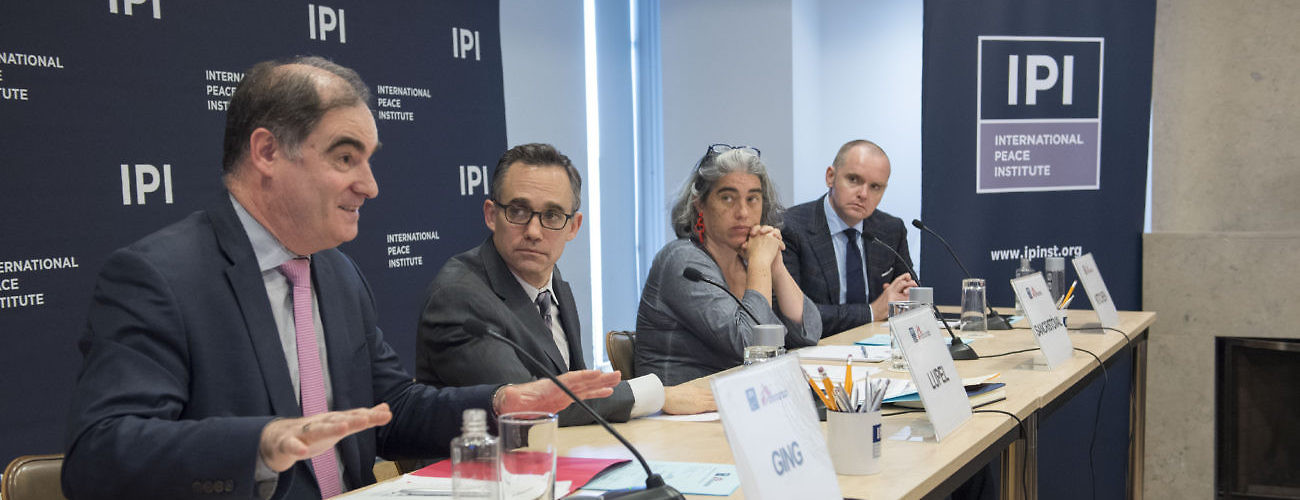A May 18th IPI policy forum co-sponsored by Médecins Sans Frontières/Doctors Without Borders (MSF), explored concrete ways to reinforce the emergency response capacity of the humanitarian sector in complex, acute crises and to ensure that humanitarian actors adequately act in both emergencies and more protracted crises.
Moderator and IPI Vice President Adam Lupel referenced research from MSF’s Emergency Gap Project, which revealed that “the first few months of acute crises are too often marked by a failure to provide lifesaving assistance and protection to those affected by violence–that there is, in fact, an ‘emergency gap.’”
Teresa Sancristóval, Director of Operations of MSF, outlined the context in which humanitarian aid organizations operate and the barriers that they face in delivering immediate service and operating in what she referred to as a “humanitarian space.”
“Being capable or not to respond to emergencies is a decision,” she said. “If today we don’t decide that we want to keep the humanitarian space, or that we want to be able to be fast in the next big crisis, it will be impossible.”
Best fulfilling the needs of humanitarian organizations to provide assistance, she said, can sometimes create conflict with the state. “You have to prepare yourself,” she said, “You have to take decisions that sometimes are hard [regarding] where you invest your money, where you invest your learning, and where you invest your preparedness.”
Ultimately, the question, is “not if we can go,” she said. “We have to go–we have to have humanitarian space, and we have to have the agility to respond to the needs of the population.”
Highlighting the need for investing in prevention capacity, Bob Kitchen, Vice-President of Emergencies at the International Rescue Committee (IRC), spoke about his own experience of acting with depleted resources. He said that eight years ago the IRC had found that “our emergency response muscles had atrophied.” As a result they invested “heavily” to increase its capacity in advance of crises.
But an obstacle to doing so was funding, he said. “We need to see a change in the donor community’s outlook on investing upfront. They have to invest in capacity and not just in response. An analogy that I use quite frequently is that firefighters don’t get paid on a per-fire basis. Neither should aid organizations; we’re saving lives every day. Firefighters don’t have to raise funds from private donors to maintain readiness to respond, which is the response we get from donors every day.”
He shared his vision for improvement which included building capacity, empowering risk analysis and response plans, establishing clear metrics for success and managing performance against those metrics within preparedness, as well as measuring the response of the organization as a whole and the a wider community compared to their goals. Through these measures, he said, “We will hold ourselves accountable to these sectors, we will be present, we will deliver this percentage to the population, and after each response, measure whether we’ve done that and figure out what went wrong and what we did right towards driving a cycle of continuous improvement.”
In a stirring call to action, John Ging, Director of Operations in the United Nations Office for the Coordination of Humanitarian Affairs (OCHA) said, “My overall message here this afternoon is that as a world, we are losing our humanity, full stop. And then we all have to ask ourselves what we can do differently to do better in terms of projecting humanity. It’s in our self interest to do so…We’re not talking about charity, we’re not talking about generosity, we’re talking about enlightened self interest.”
He emphasized the need for political support, saying, “There are far too many people in the world today who are dying because we don’t have that clarity of focus on humanitarian action.” In order to develop an effective approach, functioning systems will be mindful of the “so-called nexus between keeping people alive, which is the humanitarian response and the development [response],” he said. Implementing a combination of humanitarian development and peace and security measures would ensure that “we know that we have to do more than just keep people alive,” he said.
Building the capacity to do so repeatedly relies on funding, he explained. “The problem is that there’s a huge disconnect,” he said, framing a proposal for budgetary reform. Since the global military spending is $17.3 trillion, he asked, “is it going to be such an alarming negative consequence for the planet if less than one percent was shifted from that expenditure over to the development and humanitarian side?” He brought up the possible effects this would have and the lives it might improve. “Those hundreds of thousands of kids…they will be saved…do the calculation of what is the consequence,” he asked of the audience.
Mr. Ging explicitly challenged “those who have the authority to do it, to do it…And if, of course, you can prove that more people will die and suffer needlessly if we cut the military expenditure by less than one percent to fund all of the humanitarian needs globally, then we can move on and have a look at the other things that money is being spent on.”
Asked how to manage on a lower budget, Mr. Ging responded, “We have to step up now and really address these issues and not accept that we don’t have the money to save these kids. Because we do have the money to save these kids but we’re not having the right discussion about it.”








